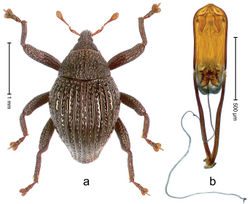Trigonopterus empat
| Notice: | This page is derived from the original publication listed below, whose author(s) should always be credited. Further contributors may edit and improve the content of this page and, consequently, need to be credited as well (see page history). Any assessment of factual correctness requires a careful review of the original article as well as of subsequent contributions.
If you are uncertain whether your planned contribution is correct or not, we suggest that you use the associated discussion page instead of editing the page directly. This page should be cited as follows (rationale):
Citation formats to copy and paste
BibTeX: @article{Riedel2014ZooKeys, RIS/ Endnote: TY - JOUR Wikipedia/ Citizendium: <ref name="Riedel2014ZooKeys">{{Citation See also the citation download page at the journal. |
Ordo: Coleoptera
Familia: Curculionidae
Genus: Trigonopterus
Name
Trigonopterus empat Riedel sp. n. – Wikispecies link – ZooBank link – Pensoft Profile
Diagnostic description
Holotype, male (Fig. 30a). Length 2.24 mm. Color of antennae and tarsi ferruginous; remainder dark ferruginous to black; elytra with slight bronze lustre. Body subovate, in dorsal aspect and in profile with weak constriction between pronotum and elytron. Rostrum with median ridge and pair of submedian ridges, intervening furrows each with sparse row of mesad directed scales; epistome with transverse subangulate ridge. Pronotum coarsely punctate, interspaces longitudinally rugose; with median costa; with sparse, suberect scales. Elytra with striae deeply impressed, each with row of slender suberect scales; intervals costate, subglabrous; in basal half incised suture bordered by row of punctures. Femora with simple, crenate anteroventral ridge. Metafemur subapically with stridulatory patch. Metatibia apically with uncus, without premucro. Abdominal ventrite 5 flat, coarsely punctate. Penis (Fig. 30b) with sides of body subparallel; apex broadly angulate, medially rounded and sparsely setose; in apical third with pair of elongate sclerites converging to orifice; transfer apparatus compact, symmetrical; apodemes 1.8 × as long as body; ductus ejaculatorius without bulbus. Intraspecific variation. Length 2.18–2.24 mm. Female unknown.
Material examined
Holotype (MZB): ARC2192 (EMBL # LM655648), East Nusa Tenggara Prov., Flores Isl., Ruteng, Danau Ranamese, sample 1, S08°37.705', E120°33.702', 1320 m, 08-III-2011. Paratypes (SMNK): Flores Isl., Ruteng, Mt. Ranaka: 1 ex, ARC2583 (EMBL # LM655892), sample 9, S08°37.641', E120°31.204', 1685 m, 10-III-2011.
Distribution
East Nusa Tenggara Prov., Flores (Ruteng). Elevation: 1320–1685 m.
Etymology
This epithet is based on the Indonesian word for “four” and is treated as a noun in apposition.
Notes
Trigonopterus empat Riedel, sp. n. was coded as “Trigonopterus sp. 303” by Tänzler et al. (2014)[1].
Original Description
- Riedel, A; Tänzler, R; Balke, M; Rahmadi, C; Suhardjono, Y; 2014: Ninety-eight new species of Trigonopterus weevils from Sundaland and the Lesser Sunda Islands ZooKeys, (467): 1-162. doi
Images
|
Other References
- ↑ Tänzler R, Toussaint E, Suhardjono Y, Balke M, Riedel A (2014) Multiple transgressions of Wallace’s Line explain diversity of flightless Trigonopterus weevils on Bali. Proceedings of the Royal Society B: Biological Sciences 281: 20132528. doi: 10.1098/rspb.2013.2528
